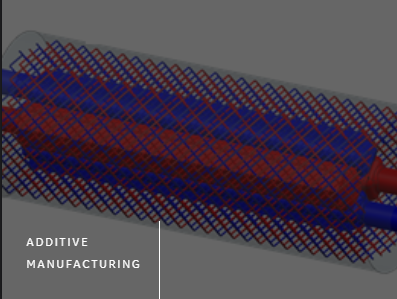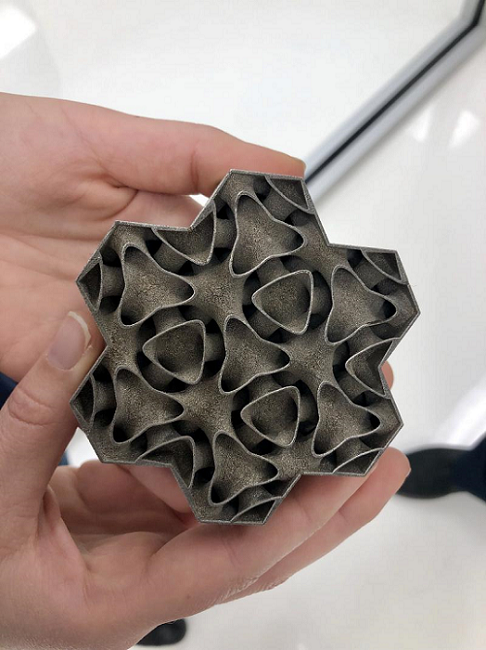Heat exchangers are designed to efficiently transfer heat from one matter to another, and are being increasingly produced through the use of 3D printing these days, as the technology can increase their design customization and reduce corrosion. Now, GE Research, a team of over 1,000 scientific, marketing, and engineering minds working to deliver new capabilities and innovations, is using its metal 3D printing expertise to lead an interdisciplinary team of experts in the design of a more efficient compact heat exchanger for power generation systems.
The $2.5 million heat exchanger project is being run through the Advanced Research Projects Agency’s (ARPA-E) High Intensity Thermal Exchange through Materials and Manufacturing Processes (HITEMMP) program. 3D printing will enable the new high-pressure, high-temperature heat exchanger to achieve cleaner power generation, with lower emissions, in current and next generation power plant platforms.
“What’s interesting is how 3D printing is allowing us to take better advantage of our knowledge in metal alloys and thermal management to design a more optimal heat exchanger,” Todd E. Alhart, GE Research Executive – Media Relations and Chief Technology Storyteller, told 3DPrint.com.
The novel 3D printed Ultra Performance Heat Exchanger, or UPHEAT, will be able to operate at temperatures of over 1,650°F and pressures greater than 3,625 psi. GE Research experts in 3D printing, high temperature metal alloys, and thermal management are working with Oak Ridge National Laboratory (ORNL) and the University of Maryland (UMD) to develop the UPHEAT, which can be used for advanced aviation and power applications, thanks to its increased energy efficiency.
According to Peter deBock, a Principal Thermal Engineer for GE Research and project leader on the ARPA-E award, heat exchangers act as lungs in the human body do:
“Lungs are the ultimate heat exchanger, circulating the air you breathe to keep the body functioning at peak performance while also regulating your body’s temperature. Heat exchangers in power generation equipment like a gas turbine essentially perform the same function, but at much higher temperatures and pressures. With additive manufacturing, GE and University of Maryland will now explore more intricate biological shapes and designs to enable a step change in heat exchanger performance that delivers higher efficiency and lower emissions.”
The overall goal of the project, which is projected to last over two years, is to develop the 3D printed heat exchanger and successfully demonstrate it at its full pressure and temperature capabilities.
 The UPHEAT will use a unique, crack-resistant nickel superalloy, capable of withstanding high temperatures, that was designed specifically by GE Research for 3D printing. While GE experts work with UMD on researching biological shapes to make the heat exchanger more efficient, ORNL will be calling on its corrosion science skills to test and validate the long-term performance of this new material. Once the 3D printed heat exchanger is complete, it should be able to deliver a 4% improvement in the thermal efficiency of indirectly-heated power cycles, like supercritical carbon dioxide (sCO2) Brayton power generation, in addition to lowering emissions and energy consumption.
The UPHEAT will use a unique, crack-resistant nickel superalloy, capable of withstanding high temperatures, that was designed specifically by GE Research for 3D printing. While GE experts work with UMD on researching biological shapes to make the heat exchanger more efficient, ORNL will be calling on its corrosion science skills to test and validate the long-term performance of this new material. Once the 3D printed heat exchanger is complete, it should be able to deliver a 4% improvement in the thermal efficiency of indirectly-heated power cycles, like supercritical carbon dioxide (sCO2) Brayton power generation, in addition to lowering emissions and energy consumption.
“We’re taking our deep knowledge in metals and thermal management and applying it in ways we couldn’t have before through the power of 3D printing. With 3D printing, we can now achieve new design architectures previously not possible. And this will allow us to create an ‘UPHEAT’ device that can operate cost effectively at temperatures 250°C (450°F) degrees higher than today’s heat exchangers,” said deBock.
If the UPHEAT project is successful, it could lead to more opportunities for heat exchangers capable of withstanding high temperatures in advanced aerospace applications.
Discuss this story and other 3D printing topics at 3DPrintBoard.com or share your thoughts in the Facebook comments below.
[Images: GE Research]Subscribe to Our Email Newsletter
Stay up-to-date on all the latest news from the 3D printing industry and receive information and offers from third party vendors.
Print Services
Upload your 3D Models and get them printed quickly and efficiently.
You May Also Like
3D Printing News Briefs, July 2, 2025: Copper Alloys, Defense Manufacturing, & More
We’re starting off with metals in today’s 3D Printing News Briefs, as Farsoon has unveiled a large-scale AM solution for copper alloys, and Meltio used its wire-laser metal solution to...
3DPOD 260: John Hart on VulcanForms, MIT, Desktop Metal and More
John Hart is a Professor at MIT; he´s also the director of the Laboratory for Manufacturing and Productivity as well as the director of the Center for Advanced Production Technologies....
3D Printing News Briefs, June 28, 2025: Defense Accelerator, Surgical Models, & More
In this weekend’s 3D Printing News Briefs, 3YOURMIND was selected to join an EU Defense Accelerator, and PTC has announced model-based definition (MBD) capabilities within Onshape. Finally, a study out...
EOS in India: AM’s Rising Star
EOS is doubling down on India. With a growing base of aerospace startups, new government policies, and a massive engineering workforce, India is quickly becoming one of the most important...




































